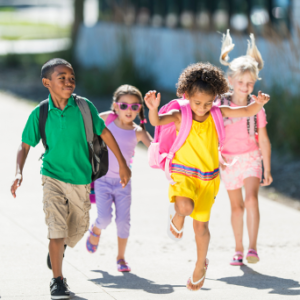New NYKids Study Findings on Equitable Disciplinary Systems
By Catherine Guthrie
In the wake of the COVID-19 pandemic, district and building leaders across the United States are tasked with reimagining what public education will look like for students when they come back to school this fall. With discussion of equity and the mental wellbeing of students being at the forefront, combined with the need to balance the potential of multiple learning environments (i.e. in-person vs. virtual), leaders will not only need to reimagine the delivery of instruction, but will also need to reimagine how to maintain student engagement and safe school environments for all students.
 To do this, district and building leaders can learn from the schools that have established and maintained equitable discipline systems despite hardships and obstacles that make it challenging to do this. Two NYKids study positive outlier schools, Malverne High School and Freeport High School, were identified as having higher than expected graduation outcomes for students of color. In this embedded study these two high schools were also identified as having proportionate, or close to proportionate, rates of exclusionary discipline for students of color and students with disabilities.
To do this, district and building leaders can learn from the schools that have established and maintained equitable discipline systems despite hardships and obstacles that make it challenging to do this. Two NYKids study positive outlier schools, Malverne High School and Freeport High School, were identified as having higher than expected graduation outcomes for students of color. In this embedded study these two high schools were also identified as having proportionate, or close to proportionate, rates of exclusionary discipline for students of color and students with disabilities.
Sharing Equity-oriented, Individualized, and Asset-based Mindsets
The cultivation of an equitable school discipline system begins with a shared mindset of high expectations for all.
- At both Malverne and Freeport high schools, all stakeholders have an “everyone can” mindset combined with a “do whatever it takes” approach towards student success that applies to both academics and behavior. This collective asset-based and growth mindset allows all stakeholders to take a “whole-child” approach where academics and behavior are two sides of the same coin, and interventions target both sides of that coin.
- This shared mindset starts with district and building leadership. Leaders set the tone of the organization, and at both Malverne and Freeport, district and building leaders showed evidence of having established shared norms, values and beliefs across the organization. These include having high expectations, providing engaging and rigorous coursework, and fostering autonomy, not just for students, but for all members of the organization.
- This mindset also includes focusing on building strong relationships between adults and between adults and students, allowing stakeholders to come together in a collaborative, problem-solving way when addressing student discipline issues. It is not a “one size fits all” approach at Malverne or Freeport. Instead, it is an individualized, whole-child approach that supports positive behavioral development.
 Building in “Implicit”, Data-based, Preventative Intervention Systems
Building in “Implicit”, Data-based, Preventative Intervention Systems
At Malverne and Freeport high schools, data analysis focused on approaches toward discipline show that student discipline is not addressed through a specific tiered intervention system for behavior. Despite this, both high schools created an environment where discipline is meted out equitably. This suggests that it is not necessarily the intervention system that matters most, rather, it’s the cultivation of a supportive school environment that is key. Through the cultivation of a supportive school environment, district and building leaders at Malverne and Freeport have created an implicit prevention system that was not specifically designed to address issues of disproportionality in student discipline, but has successfully met this aim. How do they do this?
- Creating a supportive school environment is not just about setting the tone and establishing a shared mindset that “all students can.” At Malverne and Freeport, district and building leaders have been identified as leaders who not only “talk the talk”, but they also “walk the walk.” Leaders in both districts showed evidence of doing the same work they expect their staff to engage in, from jumping into classrooms to teach to using faculty meetings to provide professional development to staff.
- Additionally, leaders in both districts reported having established ways for stakeholders to communicate and collaborate through the use of formal (committees, teams) and informal structures (ongoing teacher collaboration). This allows staff, students, leaders, and community members to come together to engage in data-driven decision making to support success for all. This has also built the capacity of the organization by allowing for leadership to be shared across the organization, and, in turn, empowering staff to address student behavior without having to seek leader intervention.
- Another component of the supportive school environment at Malverne and Freeport is the ability to be flexible and adapt to the ever changing needs of students. When viewing student behavior, staff are given the flexibility to adapt their practices to meet the needs of each individual student, allowing for “outside the box” thinking. This approach has allowed both schools to shift from a punitive to problem solving approach towards addressing student discipline issues.
As leaders move forward into the new school year, this latest embedded study of NYKids positive outlier schools suggests that shared equity-oriented, individualized, and asset-based mindsets along with built in “implicit”, data-based, preventative intervention systems are key to keeping youth engaged and schools safe.
For more information about these schools check out the Malverne case study and Freeport case study.
